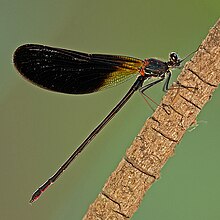Calopteryx haemorrhoidalis is a species of damselfly in the family Calopterygidae known by the common names copper demoiselle and Mediterranean demoiselle.[1]
| Calopteryx haemorrhoidalis | |
|---|---|

| |
| Calopteryx haemorrhoidalis, male | |
| Scientific classification | |
| Domain: | Eukaryota |
| Kingdom: | Animalia |
| Phylum: | Arthropoda |
| Class: | Insecta |
| Order: | Odonata |
| Suborder: | Zygoptera |
| Family: | Calopterygidae |
| Genus: | Calopteryx |
| Species: | C. haemorrhoidalis
|
| Binomial name | |
| Calopteryx haemorrhoidalis Vander Linden, 1825
| |
Subspecies
editSubspecies include:[2]
- Calopteryx haemorrhoidalis haemorrhoidalis (Vander Linden, 1825)
- Calopteryx haemorrhoidalis occasi Capra, 1945
- Calopteryx haemorrhoidalis asturica Ocharan, 1983
- Calopteryx haemorrhoidalis almogravensis Hartung, 1996
Distribution
editThis species is native to the western Mediterranean Basin in Europe (Iberia, southern France, Italy, Monaco) and North Africa (Algeria, Morocco, Tunisia). It is common in much of its range.[3][4]
Habitat
editIt lives along rivers and streams, but also in sunny larger waters. Though it may be affected by habitat changes such as water pollution.[3]
Description
editCalopteryx haemorrhoidalis can reach a body length of about 45–48 millimetres (1.8–1.9 in). The abdomen length is of about 34–43 millimetres (1.3–1.7 in) in males, of 31–43 millimetres (1.2–1.7 in) in females. The length of the wings is of 23–32 millimetres (0.91–1.26 in) in males, of 25–37 millimetres (0.98–1.46 in) in the females.[5]
The males have a dark, metallic shining body, the color of which can be red-violet, golden or copper-colored. On the underside of the last three abdominal segments there red area, the so-called "red lantern" (hence the Latin species name haemorrhoidalis, meaning "blood flow").[6] The wings of males show a large dark area, while the females have a brown band to the wing tip and a metallic-green to bronze-colored body, with a brown belt on the back.[5]
Biology
editThe flight time of this species ranges from May to September. The males have a characteristic mating dance, showing the abdomen end and spreading their wings wide. The male of this species is territorial, defending sites where females may choose to lay eggs.[7]
This species can hybridize with Calopteryx splendens.[8]
Gallery
edit-
Mating pair
-
Female
-
Calopteryx haemorrhoidalis occasi. Immature male
-
Calopteryx haemorrhoidalis occasi. Male
Bibliography
edit- B. Misof, C.L. Anderson, H. Hadrys A phylogeny of the damselfly genus Calopteryx (Odonata) using mitochondrial 16S rDNA markers. in: Molecular Phylogenetics and Evolution. Academic Press, Orlando Fla. 15.2000, 1, 5–14. ISSN 1095-9513
- K.-D. B. Dijkstra, illustrations: R. Lewington, Guide des libellules de France et d'Europe, Delachaux et Niestlé, Paris, 2007, ISBN 978-2-603-01639-8.
- Van Der Linden, 1825 : Monographiae Libellullinarum Europaearum Specimen.
References
edit- ^ World Odonata List
- ^ Catalogue of life
- ^ a b Clausnitzer, V. 2009. Calopteryx haemorrhoidalis. The IUCN Red List of Threatened Species. Downloaded on 21 January 2016.
- ^ Fauna europaea
- ^ a b Georg Rüppell: Die Prachtlibellen Europas. Neue Brehm-Bücherei Band 654, Westarp Wissenschaften Hohenwarsleben 2005; S. 203-204. ISBN 3-89432-883-5.
- ^ Gerhard Jurzitza: Der Kosmos-Libellenführer. Franckh-Kosmos Verlags GmbH & Co., Stuttgart 2000; S. 171. ISBN 3-440-08402-7.
- ^ Córdoba-Aguilar, A. (2002). Wing pigmentation in territorial male damselflies, Calopteryx haemorrhoidalis: a possible relation to sexual selection. Animal Behaviour, 63(4), 759-766.
- ^ Lorenzo-Carballa, M. O., Watts, P. C., & Cordero-Rivera, A. (2014). Hybridization between Calopteryx splendens and C. haemorrhoidalis confirmed by morphological and genetic analyses. International Journal of Odonatology, 17(2-3), 149-160.
